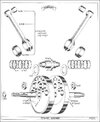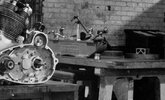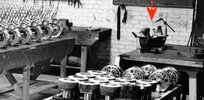Seems I have a clowns collection of dial indicators and bases.
80-90 year old lathe an acceptable fixture?
I need to know the best method of checking and improving crankshaft alignment.

Is the location of these dial indicators appropriate? top of all.
Is rotating crank on shaft end centers the best method?
Reading are 180 deg out , right side +.003/.002 when left side is zero, vice versa.
crank pin is at 90 deg front /rear at the high read.
Are these readings acceptable as is ?
or should action be taken?
I have a lead knock off hammer somewhere in my vintage sports car tool kits.
Should the E57 crankpin nut be loosened?

80-90 year old lathe an acceptable fixture?
I need to know the best method of checking and improving crankshaft alignment.
Is the location of these dial indicators appropriate? top of all.
Is rotating crank on shaft end centers the best method?
Reading are 180 deg out , right side +.003/.002 when left side is zero, vice versa.
crank pin is at 90 deg front /rear at the high read.
Are these readings acceptable as is ?
or should action be taken?
I have a lead knock off hammer somewhere in my vintage sports car tool kits.
Should the E57 crankpin nut be loosened?

Last edited:


